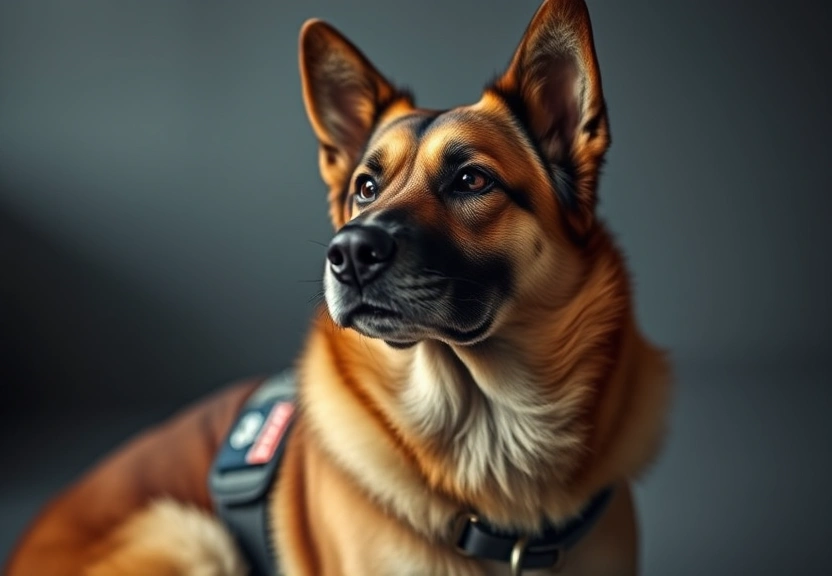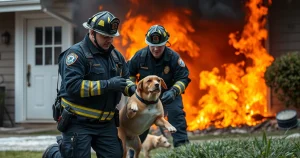Contents
ToggleA Wingman Named Cooper: How a Service Dog Helped a Veteran Heal From PTSD
On the 24th anniversary of the September 11 attacks, the nation paused to honor not only the lives lost but also the enduring scars carried by first responders and veterans. Among these scars is post-traumatic stress disorder (PTSD), a debilitating condition that impacts countless individuals who have faced unimaginable trauma. While treatment options range from therapy to medication, an increasingly recognized and effective approach involves the companionship of service dogs. This article explores the inspiring story of Cooper, a service dog whose unconditional support transformed the life of a veteran grappling with PTSD.

Veterans often find themselves battling the lingering effects of their experiences in combat, leading to feelings of isolation, anxiety, and depression. Cooper’s story exemplifies how a service dog can be more than just a pet; he can become a lifesaving wingman, aiding in trauma recovery and providing essential emotional and psychological support. Let’s delve into the journey of this incredible bond and how it symbolizes hope and healing for many veterans.
The Unseen Battle: Understanding PTSD in Veterans
Post-traumatic stress disorder is a mental health condition triggered by witnessing or experiencing a traumatic event. For veterans, this often includes combat experiences, loss of comrades, or exposure to life-threatening situations. According to the U.S. Department of Veterans Affairs, nearly 20% of veterans who served in Iraq or Afghanistan are diagnosed with PTSD.
The Symptoms of PTSD
PTSD manifests in various ways, including:
- Flashbacks and nightmares
- Avoidance of reminders of the trauma
- Increased arousal and reactivity, such as irritability and hyper-vigilance
- Negative changes in mood and cognition, including feelings of hopelessness and detachment
Understanding these symptoms is crucial for family, friends, and support networks to provide the right assistance. Yet, many veterans often feel misunderstood or invalidated, exacerbating their struggles.
🎥 Assista esta análise especializada sobre How a Service Dog Named Cooper Became a Veteran’s Lifesaving Wingman
The Role of Service Dogs in Healing
Service dogs have been recognized for their ability to assist individuals with various disabilities, including PTSD. They provide not only companionship but also practical support that can help mitigate the symptoms of this condition. Here are some of the ways service dogs facilitate recovery:
1. Emotional Support
The presence of a service dog can significantly reduce feelings of loneliness and isolation. Their unconditional love and loyalty remind veterans that they are not alone in their struggles.
2. Grounding Techniques
Service dogs are trained to help their handlers stay grounded during moments of anxiety or panic. For example, a dog might nudge or paw at the veteran, bringing them back to the present moment and helping to alleviate overwhelming feelings.
3. Routine and Structure
Caring for a service dog requires a daily routine, which can help veterans establish a sense of purpose and responsibility. This structure can be vital in combatting feelings of hopelessness and disorientation often felt by those with PTSD.
Meet Cooper: The Service Dog Who Became a Wingman
Cooper’s journey began when he was paired with a veteran named Mike, who had been struggling with severe PTSD after serving multiple tours of duty. Mike’s life was characterized by anxiety, nightmares, and a constant sense of disconnect from the world around him. The decision to adopt a service dog was a turning point for him.
The Bond Between Mike and Cooper
From their first meeting, it was clear that Cooper was more than just a service dog; he was destined to be Mike’s wingman. Cooper’s training included specific tasks designed to assist Mike, such as:
- Alerting Mike to anxiety attacks
- Providing physical comfort during episodes of stress
- Encouraging Mike to engage with the outside world
This bond not only fostered a sense of security but also helped Mike regain a sense of normalcy and control over his life.
The Impact of Cooper on Recovery
The transformation in Mike’s life after bringing Cooper into his home was profound. He reported significant reductions in anxiety and an improved ability to manage his PTSD symptoms. Here are some of the ways Cooper facilitated this change:
1. Encouraging Social Interaction
With Cooper by his side, Mike felt more comfortable engaging in social situations, whether it was visiting the local park or attending community events. This interaction was crucial in combating the isolation that often accompanies PTSD.
2. Enhancing Physical Activity
Cooper required regular exercise, which motivated Mike to get outside and stay active. Physical activity is known to have numerous mental health benefits, including the release of endorphins that improve mood.
3. Building Trust and Connection
The bond between Mike and Cooper grew stronger over time, built on mutual trust and understanding. This connection not only alleviated Mike’s feelings of hopelessness but also provided him with a sense of belonging.
Important Considerations When Seeking a Service Dog
While Cooper’s story is heartwarming, it’s essential to recognize that not every dog is suited for the demands of service work. Here are some important points to consider when seeking a service dog:
- Training: Service dogs must undergo extensive training to perform specific tasks and exhibit appropriate behavior in public.
- Compatibility: The match between the dog and the veteran should be evaluated to ensure they can form a strong bond.
- Ongoing Support: The relationship between a veteran and their service dog is ongoing and requires commitment from both parties.
- Legal Considerations: Familiarize yourself with the laws governing service animals to understand your rights and responsibilities.
Frequently Asked Questions (FAQs)
1. What is the difference between a service dog and an emotional support animal?
Service dogs are trained to perform specific tasks to assist individuals with disabilities, while emotional support animals provide comfort but are not trained to perform tasks.
2. How can I get a service dog for PTSD?
To obtain a service dog, you typically need to go through a reputable organization that specializes in training service dogs for PTSD. Assessments will often be conducted to determine compatibility.
3. Are there costs associated with getting a service dog?
Yes, obtaining a service dog can involve costs, including training, veterinary care, and supplies. Some organizations may offer financial assistance or donations.
4. Can any dog be a service dog?
No, not all dogs are suitable for service work. Service dogs need to have specific temperaments and traits, and they must undergo rigorous training to ensure they can assist their handlers effectively.
5. What should I do if I see a service dog in public?
It’s important to remember that service dogs are working animals and should not be distracted. Avoid petting or approaching them unless given explicit permission by the handler.
Conclusion
Cooper’s journey as a service dog highlights the profound impact that these remarkable animals can have on the lives of veterans suffering from PTSD. His unwavering support and companionship provided Mike with the tools necessary to navigate the challenges of trauma recovery. As we honor the sacrifices made by our veterans, stories like Cooper’s serve as a testament to the healing power of love, loyalty, and the unique bond between man and dog. For many veterans, a service dog is not just a pet but a true wingman in their journey toward healing and reclaiming their lives.
📰 Original Source
Este artigo foi baseado em informações de: https://iheartdogs.com/service-dogs-help-veterans-ptsd/?utm_source=rss&utm_medium=rss&utm_campaign=service-dogs-help-veterans-ptsd





